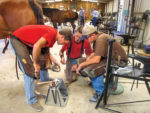Advertise Follow Us
Getting Started in Hoof Care

View Archived Issues
Seventh Edition (2015)
A Career Guide For The New Farrier
This special publication is published once per year by American Farriers Journal. The career guide delivers advice from farriers on how to establish and operate a successful equine footcare practice.
-
Table of Contents
Table of Contents
-
Digital Edition
Digital Edition













